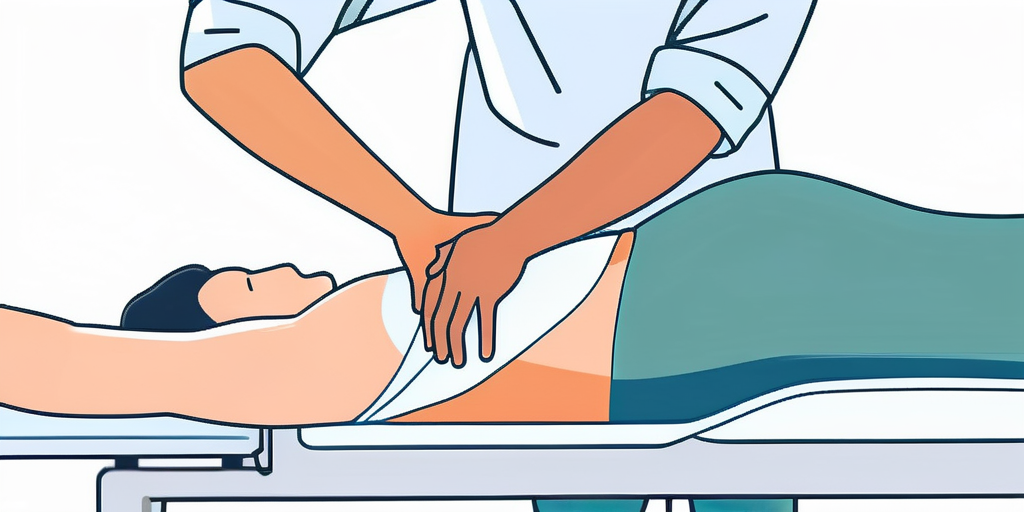Chiropractic care is an alternative treatment option that has gained popularity for its ability to help alleviate the symptoms of various musculoskeletal conditions. One such condition is scoliosis, a sideways curvature of the spine that can cause discomfort and affect a person’s overall well-being.
If you or a loved one has been diagnosed with scoliosis, it’s natural to have questions and concerns about what to expect from chiropractic care. This article will explore chiropractic care for scoliosis and its benefits.
Understanding Scoliosis and Its Impact
Scoliosis is a condition that affects the alignment of the spine, causing it to curve sideways. It can develop during childhood or adolescence, and in some cases, it can be present at birth. The severity of scoliosis can vary from mild to severe, and it can significantly impact a person’s posture, mobility, and overall quality of life. The condition can cause pain and muscle imbalances and, in severe cases, affect heart and lung function.
It’s crucial to understand that scoliosis is not a condition that can be cured but can be managed to minimize its impact on daily life. This is where chiropractic care comes into play.
Chiropractic care focuses on the relationship between the spine and the nervous system, aiming to improve overall health and well-being. For individuals with scoliosis, chiropractic adjustments can help alleviate pain, improve spinal alignment, and enhance mobility. By addressing misalignments in the spine, chiropractors can reduce the progression of the curvature and prevent further complications.
Furthermore, incorporating targeted exercises and stretches into a scoliosis management plan can strengthen the muscles supporting the spine, promote better posture, and reduce discomfort. Individuals with scoliosis must work closely with healthcare professionals, including chiropractors and physical therapists, to develop a comprehensive treatment approach tailored to their needs and goals.
How Chiropractic Care Can Help with Scoliosis
Chiropractic care focuses on addressing musculoskeletal issues through noninvasive techniques and manual adjustments. Regarding scoliosis, chiropractors can provide personalized treatment plans tailored to each patient’s unique needs. Chiropractic care for scoliosis aims not to straighten the spine completely but to improve mobility, reduce pain, and enhance overall function.

One primary way chiropractic care can help with scoliosis is by improving spinal alignment. Through gentle adjustments, chiropractors can alleviate stress on the spine and surrounding muscles, potentially reducing pain and discomfort. These adjustments can also help correct postural imbalances and enhance range of motion, improving overall function.
But what other methods do chiropractors employ to assist patients with scoliosis? Let’s explore two additional aspects of chiropractic care for scoliosis: the role of exercise and collaboration with other healthcare professionals.
The Role of Exercise in Chiropractic Care
In addition to manual adjustments, chiropractic care for scoliosis often incorporates specific exercises to strengthen the muscles that support the spine. These exercises can help improve posture, increase flexibility, and minimize the progression of the curvature. Chiropractors may also recommend specific stretches and rehabilitation exercises tailored to each patient’s needs.
Exercise plays a crucial role in scoliosis management. It helps to strengthen the muscles surrounding the spine, providing additional support and stability.
Chiropractors target specific muscle groups to improve posture and reduce spine strain caused by scoliosis. These exercises are often designed to be performed at home, allowing patients to participate actively in their recovery.
Collaboration with Other Healthcare Professionals
Chiropractors often collaborate with other healthcare professionals to provide comprehensive care for scoliosis patients. This collaborative approach may involve physical therapists, orthopedic specialists, and other healthcare professionals specializing in scoliosis treatment. Patients can benefit from a holistic approach that addresses their needs by combining different expertise and modalities.
Collaboration between chiropractors and other healthcare professionals allows a multidisciplinary approach to scoliosis treatment. This approach ensures that patients receive the most effective and well-rounded care possible. By working together, these professionals can develop a comprehensive treatment plan that may include chiropractic adjustments, physical therapy, bracing, and other interventions tailored to each patient’s needs.
As you can see, chiropractic care for scoliosis goes beyond just manual adjustments. By incorporating exercise and collaborating with other healthcare professionals, chiropractors can provide a holistic approach to help patients manage their scoliosis and improve their quality of life.
Chiropractic Techniques for Managing Scoliosis
Chiropractors employ various techniques to manage scoliosis, depending on the severity of the condition and the individual needs of the patient. Scoliosis, a condition characterized by an abnormal sideways curvature of the spine, can cause discomfort and impact daily activities. Chiropractic care addresses these issues holistically focusing on spinal health and overall well-being.
Some common chiropractic techniques used in scoliosis management include:
- Manual Adjustments: These gentle, hands-on techniques aim to improve spinal alignment and optimize nerve function. By applying controlled force to specific joints, chiropractors seek to restore mobility and alleviate scoliosis-related pain.
- Spinal Decompression: This technique gently stretches the spine to alleviate pressure and reduce pain. Spinal decompression can help relieve nerve compression and improve spinal function by creating space between vertebrae.
- Massage Therapy: Chiropractors may incorporate massage techniques to relax muscles and relieve tension. Massage therapy can help improve circulation, reduce muscle stiffness, and enhance the effectiveness of other chiropractic interventions.
- Electrotherapy involves using electrical stimulation to promote tissue healing and reduce pain. TENS (transcutaneous electrical nerve stimulation) can help manage pain and support natural healing.
- Instrument-Assisted Techniques: Chiropractors may use specialized instruments to deliver targeted adjustments and enhance overall treatment outcomes. Tools like activators or drop tables can assist in precise adjustments, ensuring optimal alignment and function of the spine.
It’s important to note that the specific techniques used will vary depending on the patient’s individual needs and the chiropractor’s approach. A comprehensive evaluation and personalized treatment plan are essential in addressing scoliosis effectively and improving the patient’s quality of life.
Benefits of Chiropractic Care for Scoliosis Patients
Chiropractic care for scoliosis offers several potential benefits for patients, including:
- Pain Relief: Chiropractic adjustments and therapeutic techniques can help reduce pain and discomfort associated with scoliosis.
- Improved Functioning: Chiropractic care can enhance overall function and range of motion by addressing spinal misalignments and muscle imbalances.
- Enhanced Quality of Life: Many scoliosis patients report improved quality of life after chiropractic care, experiencing fewer restrictions in daily activities.
- Non-Invasive Approach: Chiropractic care offers a non-invasive alternative to surgical interventions or other treatments.
- Personalized Treatment: Chiropractors create individualized treatment plans that consider each patient’s unique needs and goals.
Furthermore, chiropractic care for scoliosis focuses on restoring proper alignment and function to the spine, which can help alleviate pressure on the nerves and improve overall nervous system function. This holistic approach targets the symptoms of scoliosis and aims to address the underlying causes of the condition, promoting long-term wellness and stability.
Chiropractors specializing in scoliosis treatment often incorporate a combination of spinal adjustments, therapeutic exercises, and lifestyle recommendations to support the patient’s journey toward better spinal health. Treatment plans may also include nutritional guidance and ergonomic advice to optimize physical well-being and prevent future spinal issues.
FAQs About Chiropractic Care for Scoliosis
Here are some frequently asked questions regarding chiropractic care for scoliosis:
Is chiropractic care painful?
Chiropractic adjustments are painless, and most patients feel immediate relief after treatment.
How long does it take to see results?
The duration of treatment varies depending on the severity of the scoliosis and the patient’s response. Some patients may experience improvement after a few sessions, while others may require longer-term care.
Is chiropractic care suitable for all types of scoliosis?
Chiropractic care can benefit various types of scoliosis, but its effectiveness may vary depending on the individual case. Consulting a qualified chiropractor can help determine if chiropractic care suits a specific scoliosis condition.
Does insurance cover chiropractic care?
Many insurance plans cover chiropractic care, but you must check with your provider to determine the extent of coverage.
Are there any risks associated with chiropractic care?
Chiropractic care is generally safe, but potential risks are involved with any medical treatment. It’s crucial to discuss any concerns or pre-existing conditions with your chiropractor before starting treatment.
As with any healthcare decision, it’s essential to consult a qualified healthcare professional to determine if chiropractic care suits your scoliosis. By working closely with a chiropractor, you can develop a personalized treatment plan that addresses your unique needs and goals, helping you navigate your scoliosis journey more comfortably and easily.
It’s important to understand that each case of scoliosis is unique. The severity of the curvature, the patient’s age, and other individual factors play a significant role in determining the most effective treatment approach. Chiropractic care offers a noninvasive and drug-free option for managing scoliosis, focusing on improving spinal alignment and reducing discomfort.
During a chiropractic session for scoliosis, the chiropractor thoroughly examines the patient’s spinal alignment and identifies any misalignment or restricted movement areas. Based on this assessment, the chiropractor creates a personalized treatment plan that may involve spinal adjustments, therapeutic exercises, and other complementary therapies.
It’s important to note that chiropractic care is not a standalone treatment for scoliosis. It is often used as part of a multidisciplinary approach, working with other healthcare professionals such as orthopedic specialists, physical therapists, and pain management experts. This collaborative approach ensures that patients receive comprehensive care tailored to their needs.



